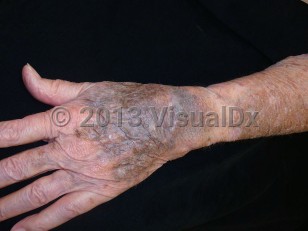Amiodarone drug-induced pigmentation
See also in: External and Internal EyeAlerts and Notices
Important News & Links
Synopsis

Skin effects – Blue-gray pigmentation of sun-exposed skin is common. Skin effects also include vasculitis and photosensitivity (30%-50% of patients on amiodarone). Skin pigmentation can develop 6 months to 5 years after beginning therapy.
Ocular effects – Amiodarone will induce mitochondrial deposits in the deep epithelial layer of the cornea. These deposits will form a whorl-like epitheliopathy called "corneal verticillata," or vortex keratopathy. The deposits are barely visible without the aid of a slit lamp and rarely result in any reduction in vision or ocular discomfort. The corneal verticillata are typically found on routine eye exam and are not an indication for discontinuation of the medication. Most patients using amiodarone will develop corneal deposits. Upon discontinuation of the medication, the deposits typically resolve.
Thyroid effects – Adverse events include either hypothyroidism or hyperthyroidism with skin manifestations of myxedema.
Codes
T50.995A – Adverse effect of other drugs, medicaments and biological substances, initial encounter
SNOMEDCT:
110284009 – Drug-induced pigmentation
Look For
Subscription Required
Diagnostic Pearls
Subscription Required
Differential Diagnosis & Pitfalls

Subscription Required
Best Tests
Subscription Required
Management Pearls
Subscription Required
Therapy
Subscription Required
Drug Reaction Data
Subscription Required
References
Subscription Required
 Patient Information for Amiodarone drug-induced pigmentation
Patient Information for Amiodarone drug-induced pigmentation - Improve treatment compliance
- Reduce after-hours questions
- Increase patient engagement and satisfaction
- Written in clear, easy-to-understand language. No confusing jargon.
- Available in English and Spanish
- Print out or email directly to your patient



